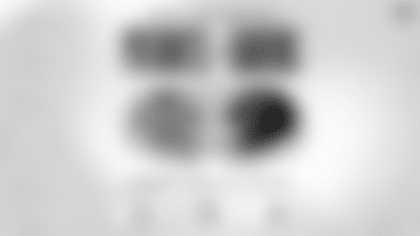Facing a Bill Belichick defense, even in a preseason dress rehearsal, was a difficult draw for second-overall draft selection C.J. Stroud in his Texans debut on Thursday night.
Although the national pundits will likely focus on Stroud's shaky performance, what caught my eye from the contest was how much even the Patriots second-stringers threw at Houston's offense in the roughly 25 snaps of work that projected contributors like Mills, White, and first-round draft pick Christian Gonzalez got on Thursday night.
The preseason is usually as vanilla as it gets scheme-wise, and it mostly was on the other side of the ball. For example, with undrafted rookie Malik Cunningham at quarterback in the fourth quarter, offensive coordinator Bill O'Brien essentially ran the same passing concept on four of Cunningham's five drop-backs. The Patriots defense, on the other hand, is already starting to throw Ph.D.-level stuff at opposing quarterbacks, even playing without most of their starters.
Patriots defensive play-caller Steve Belichick cycled through five different coverage types, disguised safety shells often pre-snap, and brought five-plus rushers on 13 of Houston's 31 passing plays. The Pats also played three coverage snaps in cover zero, continuing to lean on their man coverage roots with a 54.8 percent man coverage rate, per NextGen Stats.
Given the personnel and the fact that it was the preseason, Stroud didn't have the luxury of facing a bland defense on Thursday night. More importantly, for the Patriots, Belichick's play-calling tendencies were a precursor to the team's in-season plans on defense.
For a defense that returned ten of its 11 starters this offseason, the lone departure was a big one in the retirement of future Patriot Hall of Fame safety Devin McCourty. McCourty patrolled the deep part of the field in Belichick's primarily single-high defense for 13 seasons. His performance and leadership on and off the field will be extremely difficult to replace.
However, even with projected starters Kyle Dugger and Adrian Phillips sitting this one out, we still got a preview of what's to come in the post-McCourty era: disguise, disguise, disguise.
The Patriots had defensive backs Joshuah Bledsoe (13 snaps), Myles Bryant (12), Mills (four), and Shaun Wade (29) take turns playing free safety on Thursday night, as they kept Houston's quarterbacks guessing as to what the post-snap picture would look like before the snap.
For example, Mills's first-quarter interception of Stroud was rooted in disguise. First, take note of the outside corners, Gonzalez (top of screen) and Jack Jones (bottom of screen), lining up pre-snap in off-coverage with their hips open and eyes on the quarterback. Typically, that signals to quarterbacks that they're getting zone coverage. Then, the Pats are in a two-high shell on third-and-21, making this look like a quarters structure to the QB.
Once the ball is snapped, Mills, despite starting from depth, is actually in man coverage on the tight end in the backfield to Stroud's right. Stroud eventually ID'ed man coverage, expecting the tight end's delayed release into the flat to pull Mills out of the passing lane, opening a window to the deep outside curl. Instead, Mills had fallen off his man, who initially stayed in to block, to make a play on the ball, which he explained after the game.
"I was actually in man-to-man with the tight end. He was in the backfield, though. It was a longer down and distance, so I kind of showed a two-high look," Mills began. "Once the tight end kind of chipped and released through, I knew I could take him from depth, but I just kept my eyes on the quarterback. I was able to get underneath the route and intercept the ball."
The Patriots disguising didn't stop after Mills's interception. They also dialed-up cover zero blitzes (man with no deep safety) from disguised two-high safety shells. Above, there are zero pre-snap indicators that the Pats are bringing six rushers. The safeties are in a two-high shell, and the second level is off the line and stagnant. However, when the ball is snapped, Jahlani Tavai and Jabrill Peppers blitz, Mills rotates to take the tight end, and Bledsoe covers the running back. The six-man pressure forces the Texans O-Line to block down, leaving Anfernee Jennings as a free rusher, and Stroud has to throw "hot" while under pressure to no avail.
Following Devin McCourty's retirement last offseason, the Patriots legend took to Twitter to quell fans' concerns about the void he left behind in the defense. McCourty said the Pats will be less predictable without him always ending up in centerfield, and even in the opening preseason game without a slew of starters, the Patriots defense had the dial spinning. Although the offense has work to do, Bill Belichick's defense flexed its versatility and depth, high IQ, and young playmakers on Thursday night.
Here are three more takeaways and quick-hit film notes from the Patriots loss to the Texans After Further Review:
1. What Were the Biggest Areas of Concern for the Patriots Second-String Offense?
Before we get into the offensive lowlights, we must keep Thursday night's struggles in perspective; the Pats sat almost all their starters, including quarterback Mac Jones, his top playmakers, and two of their healthy starters on the O-Line (Trent Brown, David Andrews).
The group that managed 89 total yards and three first downs on 29 plays with backup Bailey Zappe under center isn't the group that will face the defending NFC champs in 30 days. It's fair to be concerned about New England's depth along the offensive line, especially given the inconsistent availability of its starters, and evaluate certain players who project as contributors.
However, it's not surprising that an offensive unit that hasn't played much together and featured primarily backups struggled with the details on Thursday night. Upon review, there were fewer one-on-one pass-rush losses than it felt live, with Zappe under pressure on a manageable 29.4 percent of his drop-backs. The pressures for the game were charged to: Andrew Stueber (2), Chasen Hines (2), Conor McDermott (1), Sidy Sow (1), and tight end Matt Sokol was responsible for a sack. In all, not terrible, but that wasn't what the eye test suggested.
A big reason why the eye test made the performance feel worse than the metrics was because the pass protection struggled with Houston's schemed rushes, leading to free runners at the QB.
The Texans broke down New England's protection rules with what are called "coffee house" blitzes. On the first third down for the Patriots offense following Mills's interception, you can see from the birds-eye view that Zappe has two open receivers to his left on a simple curl-flat combination, but he's already under pressure once he hits the top of his drop as number-three overall draft pick Will Anderson is turning the corner on right tackle Sidy Sow.
Anderson's pressure forces Zappe to look for air space in the pocket. However, here comes the coffee house. Linebacker Denzel Perryman (#6) is lined up in-line over the center with five rushers on the line. Perryman initially mimics like he will drop into coverage, so center James Ferentz opens to his right, thinking he's in a help position. Instead, Perryman is bluffing and ends up coming downhill on a blitz. With Anderson hurrying Zappe up into the pocket, Perryman closes it shut, and the Pats QB doesn't have the time to move the chains.
RUNNING GAME
The coffee house blitzes fooled the Patriots offensive line on both sacks with Zappe under center, and things were even shakier in the running game for the big boys up front.
According to Pro Football Focus, only center James Ferentz received a game grade above 70.0 as a run-blocker. There were far too many instances where guys were late coming off their combination blocks, failed to generate movement on double-teams, and some overzealous reps where offensive linemen were getting overextended by firing too quickly out of their stances.
Although the blocking was an issue, the Patriots running backs without Rhamondre Stevenson also didn't add much imagination to their runs. New England's expected rushing yards on running back carries, excluding QB runs, was 60 yards, while their actual rushing yards were 35, for a lousy rushing yards over expected of -25. With the Pats sniffing around the veteran free-agent market, the current RBs on the roster didn't do themselves any favors (hello, Zeke?).
For example, O'Brien had a vanilla play sheet in his return to NFL play-calling for the first time since the 2020 season, but the Pats OC did call several run-pass options (RPOs).
Here, the Patriots are running a counter scheme with a wide receiver screen attached to Zappe's right. Zappe correctly reads the defense playing two-over-two on the screen and hands the ball off to second-year running back Pierre Strong, who begins to follow the blocking.
As Strong follows the blocks, the second level of the Texans defense flies to the puller. Specifically, watch linebacker Henry To'oTo'o (#39) on the weak side. To'oTo'o starts working over the top as rookie Atonio Mafi climbs to the second level. With the backside edge rusher coming upfield and To'oTo'o over-pursuing, there's a giant cutback lane to Strong's right if he sees it. With Strong's speed and the defensive back covering Tre Nixon on the screen filling late, the Pats running back might've been running for a while if he hits that cutback lane. Instead, Strong runs full-speed into the crowd and only picks up a few yards.
Ideally, Strong would be more patient there while his blocks are developing, especially since there aren't any immediate penetrators into the backfield. The RPOs will open rushing lanes because defensive backs who might have run-game responsibilities have to play pass, but the running backs need to show better vision and patience.
As for fellow second-year running back Kevin Harris, the stat's don't look great with eight attempts for just ten yards. He missed an opening to the right of center on the fourth-and-one stuff. To Harris's credit, he did force three missed tackles, producing 17 yards after contact -- a bowling ball-style back who needs a runway to get moving.
Strong had a few nice runs once undrafted rookie Malik Cunningham came in, which will get to next. Still, we need to see better decision-making from the 2022 draft picks.
2. What do the Patriots Have in Undrafted Rookie QB/WR Malik Cunningham?
The Patriots offense was stagnant until Cunningham took over at quarterback for the final offensive possession, with the undrafted rookie leading the offense on a 14-play, 75-yard touchdown drive.
With a Texans defense filled with ex-Patriot castoffs closing out the game, it wasn't like Cunningham went through the 2003-04 Patriots defense like a hot knife through butter. Still, the rookie is an impressive ball carrier and was better as a thrower than expected. Plus, the schematic advantages his mobility brings were apparent.
Although he mostly ran a variation of the same passing play four-out-of-five times, O'Brien quickly pivoted to zone-read concepts and empty formations to allow Cunningham's athleticism to shine. In a very watered-down way, it was reminiscent of certain things O'Brien did with a young Deshaun Watson (please don't take that too far. I'm just talking schemes).
First, Cunningham's mobility allowed the Patriots to run zone-read concepts, where the quarterback reads the backside defenders, often an unblocked edge rusher and makes a post-snap decision whether to keep the ball or hand it off to the back. Above, the defensive end crashed down to take the back, so Cunningham kept the ball himself.
After showing the QB keeper, the Patriots returned to zone-read on a fourth-and-two call. This time, you can see the influence Cunningham has on the backside, where the EDGE and safety on the tight end in man have to stay home, opening up a huge lane for Strong to move the chains.
On Cunningham's nine-yard touchdown run, the Pats spread the field in empty. With a mobile QB, empty is great because it makes it easy for the quarterback to read the defense, and he can be his own check-down/pass protection by scrambling. The Pats ran essentially the same play out of four empty calls, a three-man stick concept to Cunningham's right, with curl/slant-flat to Cunningham's left. When he doesn't like the pass options, the Pats QB scores on his own.
If you think the Patriots should seriously consider starting Cunningham at quarterback, calm the 'f' down. For now, I'm not sure what he is; quarterback, receiver, scout-team QB, Taysom Hill, who knows? But the reality is, for an offense that might need every playmaker it can find, Cunningham is a dynamic runner. I'm not ruling out a Cunningham read-option package as a trick up their sleeve.
3. Breaking Down First-Rounder Christian Gonzalez's 13 Coverage Snaps
The rookie class is having a great summer, and even with LB/S Marte Mapu (not cleared for contact) and Demario Douglas (parked in the garage) mostly sitting this one out, we saw the potential on Thursday night, especially from second-round pick Keion White.
Gonzalez's debut, which lasted 25 snaps, 13 in coverage, wasn't as banner-worthy as White's, but there were some good things on film for the first-rounder. Mainly, Gonzalez's silky smooth movement skills and footwork flashed plenty, as did his burst out of his transitions.
Starting with the good, you routinely see Gonzalez's incredibly smooth man coverage skills in practice, and he put that on tape against Texans WR Nico Collins above (top of screen). Gonzalez's ability to transition his hips and stop down with little wasted movement is impressive.
However, there are times when his route anticipation could improve. The 12-yard completion he gave up to Steven Sims was a challenging route to cover. Gonzalez is playing a crosser with outside leverage and only has post-safety help on the bootleg action, making it easy for Sims to run away from him. Still, you'd like to see Gonzalez stick with the receiver more at the top of the route by understanding that, from that alignment, Sims is likely running a crosser. Corners must think about the inverted over, where the receiver stems inside before breaking out, so you have to respect that. But, eventually, Gonzalez will start getting earlier reads on routes.
There were a few welcome to the NFL moments with how physical the Texans' receivers were downfield, and, again, Gonzalez is still learning how to read routes. But there wasn't anything to suggest that the rookie won't put it all together eventually. He moves so easily out there.
4. Quick-Hit Film Notes from Patriots-Texans, Preseason Game 1
- As we documented on Twitter/X here, rookie Keion White was dominant in this one with three quarterback pressures (one QB hit), several fundamentally sound reps against the run, and an explosive gear that Stroud probably is feeling today. White playing well from multiple stances/alignments was extremely impressive.
- Bailey Zappe mostly did what he could out there. You do wonder how much his height is a factor when it comes to handling pressure, though. There were opportunities to beat pressure that he didn't seem to see, but it's tough to know that without being inside the quarterback's head.
- Anfernee Jennings was almost as good as White in this one. Jennings drew a hold on a three-man stunt, went right around the right tackle with an inside move for another pressure, and had the fastest average get-off of any Pats pass-rusher at 0.78 seconds on his 15 pass-rush snaps—a really good showing.
- I went into this film with an open mind about anyone playing well on the offensive line amongst the group that started the game. Ferentz was okay but far from perfect, and Hines and Russey had a few nice reps when they had help. Otherwise, this was a rough tape. In particular, I hoped to see more power at the point of attack from Mafi.
- Conor McDermott looked better in limited work at right tackle (six snaps) than he did on the left side. Still, foot speed is an issue here, and that'll need to be schemed around if he's the starting right tackle in Week 1.
- Sidy Sow's transition back to tackle is not going very well. Sow is struggling to get the footwork down at tackle, primarily having issues with his initial kick-slide to get out of his stance and into his pass set. He's not getting any depth, causing him to have a short corner, and then he's trying to overcompensate from there, compromising his hand placement and balance. It's a difficult movement to learn, but the struggles suggest Sow won't be an option to play tackle as a rookie.
- Demario Douglas ran one route, an inside seam/go out of four verticals, and did a nice job stemming at the safety to get the inside track. After watching the play a few times, I thought Zappe had a chance to get him the ball.
- Kayshon Boutte didn't have very many downfield wins. I had him open twice against zone/off-coverage on a hitch and an in-cut, but the burst to pull away from man wasn't there. Release quickness was ok. Just couldn't run by anyone on his verticals.
- Typical performance for Jack Jones. He had some really good reps where he smothered receivers in man coverage. Still, he should've given up a chunk play to Tank Dell on a fade (overthrown by Davis Mills) and got a little loose at times at the break point. Overall, he's a fine cover corner and a great ballhawk. But you wonder how many plays he'd give up with a larger role.
- I would've liked to have seen a more assignment-sound performance by Joshuah Bledsoe. He got himself washed out of the play a few times filling the run from the second level, and was in the area on a few completions where the short-zone distribution could've been better. Bledsoe logged a team-high 74 snaps on Thursday night, showing that the team knows he needs more game reps to develop.
- Daniel Ekuale struggles to hold the point of attack when he's doubled/comboed in the run game. But if you single-block him, he wins his fair share of reps. His one-on-one pass-rush toolbox is legit, while he also easily pressed the center to reset the line of scrimmage and shed the block for a stuff late in the second quarter. Ekuale projects as another interior pass-rusher, so he won't be asked to play the run much. Right now, I think he makes the team.
- Sam Roberts is a strong dude with an explosive first step. He needs to improve his pad level after initial contact. He gets too tall. But the power/explosiveness is there to be a rotational IDL on an NFL roster. My guess is that he spends the year on the practice squad, where DeMarcus Covington and Joe Kim can work with him.
- Rough night for Rodney Randle, who gave up a team-high eight catches for 75 yards. Nobody expects Randle to make the roster, but he struggled in this one.
- Isaiah Bolden had a tough rep against Tank Dell on the TD, where he lost at the line of scrimmage on the release. But his kick return ability stood out, and Bolden fared well in the rest of his coverage snaps – a player to watch on the 53-man roster bubble.
- By the mid-way point in the third quarter, the Patriots defense was playing mostly guys who are, at best, competing for roster spots. Bledsoe and Bolden were the surest things out there. This was a typical first preseason game, where the bulk of the snaps went to players fighting to make the roster.
DISCLAIMER: The views and thoughts expressed in this article are those of the writer and don't necessarily reflect those of the organization. Read Full Disclaimer















































